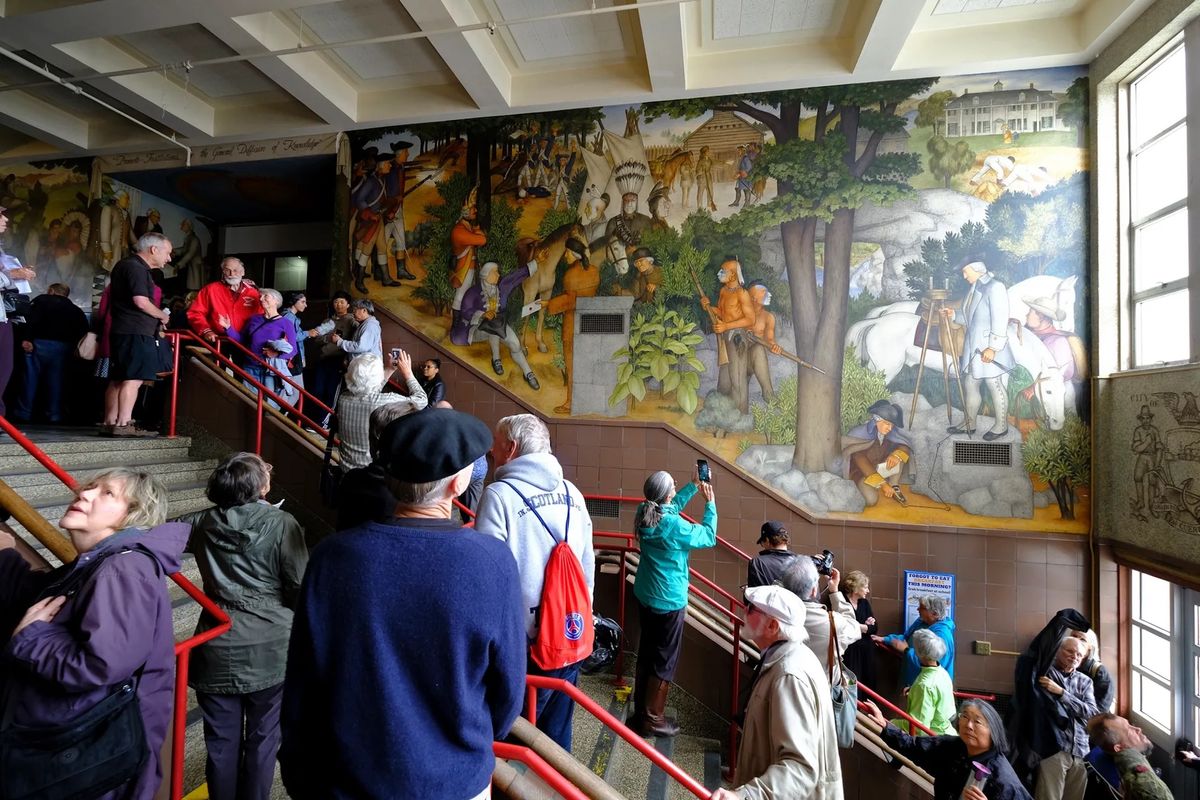A mural depicting scenes from George Washington’s life that became a lightning rod for controversy will remain on view in a San Francisco high school, following a vote by the city’s school board. The decision last Wednesday marks a reversal of a 2019 vote to cover up the painting, which some have called violent and racist, a move that drew accusations of censorship.
Titled Life of Washington, the 1934 mural lines the entryway of George Washington High School and consists of 13 panels. Three have ignited heated debate for portrayals of enslaved people at Mount Vernon, a Native American with a scalp on his belt and a dead Native American at Washington’s feet. The 1,600-sq.-ft work was painted by Victor Arnautoff, a Russian immigrant who was commissioned by the Works Progress Administration, and has been seen by some as being critical of Washington and the United States’ founding myths.
An updated press release from George Washington High School Alumni Association (GWHSAA), which has supported the frescoes’ continued display, describes them as “the largest surviving works by Victor Arnautoff, an avowed leftist who wanted to show the truth about Washington as a conflicted man who accomplished great things but was grounded in the twin sins of early America—slavery and oppression of Native Americans, aspects of United States history which were not discussed in high school texts of the time. His later mosaics on the exteriors of buildings in Mariupol, Ukraine, may have been destroyed in the Russian invasion of 2022”.
Academics and art historians have also rallied for the work to stay, with more than 400 prominent figures signing a letter advocating for its preservation. Still others, particularly many Black and Native members of the community, have argued that the imagery is traumatic and commemorates the triumphs of settler colonialism. Paloma Flores, a member of the Pit-River Nation and former coordinator of the school’s Indian Education Program, told the New York Times in 2019 that Arnautoff’s “intent no longer matters”, adding that the murals “glorify the white man’s role and dismiss the humanity of other people who are still alive”.
In 1968 and 1969, the school’s Black Student Union protested the depiction of enslaved people, which led the school board to hire Dewey Crumpler, a Black artist, to paint additional murals on campus that reflect the experiences of people of colour. But backlash erupted again in 2018 amid a nationwide reckoning over the fate of statues, monuments and other works that commemorate Confederate history. The following year, the board voted unanimously to paint over the murals, with then-vice president Mark Sanchez describing the gesture as “reparations”; members later changed course and decided to cover up the panels.
The issue was also challenged in court in a suit filed by GWHSAA against the board and the school district. A state judge eventually ruled that the district violated California laws by failing to conduct an environmental review of their course of action prior to voting on the mural’s fate.
Wednesday’s 4-3 vote comes four months after a heated recall board election—the city’s first in nearly four decades—in which voters ousted three members, one of whom had voted in 2019 to cover the painting. Debate over the fate of Arnautoff’s works may still arise, but “it is unlikely that the current BoE will initiate new proposals in the near future for removing the murals”, GWHSAA’s press release states. The alumni group now intends to pursue solutions it has previously proposed to further protect the New Deal-era work, including developing permanent signage for it and updating murals-related curricula so it can be used as an appropriate teaching tool.
“If additional issues detrimental to the murals materialise, there are options for future actions citing the California Preservation Act (CAPA) and/or federal Visual Artists Rights Act (VARA) or other relevant statutes governing public art preservation,” it notes.


